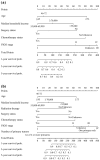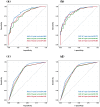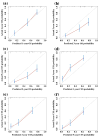Nomograms for Predicting Overall Survival and Cancer-Specific Survival of Small Cell Carcinoma of Ovary Patients: A Retrospective Cohort Study
- PMID: 40556961
- PMCID: PMC12185125
- DOI: 10.14740/wjon2543
Nomograms for Predicting Overall Survival and Cancer-Specific Survival of Small Cell Carcinoma of Ovary Patients: A Retrospective Cohort Study
Abstract
Background: This study aimed to develop functional nomograms to predict overall survival (OS) and cancer-specific survival (CSS) of small cell carcinoma of ovary (SCCO).
Methods: SSCO case data were recruited retrospectively from the Surveillance, Epidemiology, and End Results (SEER) database. Nomograms were constructed to predict the probabilities of OS and CSS in SCCO patients based on independent predictors. The predictive performance of nomogram was evaluated with the concordance index (C-index), area under the curve (AUC), calibration curves, and decision curve analysis (DCA).
Results: The independent risk factors affecting the prognosis of SCCO patients were older age, lower income, surgery, chemotherapy, radiation, advanced International Federation of Gynecology and Obstetrics (FIGO) stage, and number of primary tumors. The C-index for the OS nomogram was 0.78 (95% confidence interval (CI): 0.75 - 0.82), and AUCs for 1-, 3-, and 5-year OS were 0.861, 0.807, and 0.821, respectively. The C-index for the CSS nomogram was 0.79 (95% CI: 0.76 - 0.83), and AUCs for 1-, 3-, and 5-year OS were 0.873, 0.841, and 0.864, respectively. The calibration curves indicated reasonable agreement between the observed and predicted probabilities of the OS and CSS nomograms, which indicated a good degree of confidence. According to the C-index, ROC, and DCA, the prognostic nomograms of OS and CSS showed better prediction accuracy and clinical application value for SCCO than the FIGO staging system.
Conclusions: We constructed original nomograms that provided useful prediction of OS and CSS for patients with SCCO. These models could facilitate the postoperative personalized assessment and the identification of treatment strategy.
Keywords: Cancer-specific survival; Nomogram; Overall survival; SEER; Small cell carcinoma of ovary.
Copyright 2025 Authors.
Conflict of interest statement
There is no conflict of interest.
Figures





Similar articles
-
Development and validation of nomograms for predicting survival of locally advanced rectosigmoid junction cancer patients: a SEER database analysis.Transl Cancer Res. 2025 May 30;14(5):2808-2821. doi: 10.21037/tcr-24-1810. Epub 2025 May 27. Transl Cancer Res. 2025. PMID: 40530120 Free PMC article.
-
Dynamic nomogram for predicting the overall survival and cancer-specific survival of patients with gastrointestinal neuroendocrine tumor: a SEER-based retrospective cohort study and external validation.Front Oncol. 2025 Jun 4;15:1594591. doi: 10.3389/fonc.2025.1594591. eCollection 2025. Front Oncol. 2025. PMID: 40535122 Free PMC article.
-
Construction and validation of nomograms for predicting the prognosis of elderly patients with uterine serous carcinoma: a SEER-based study.J Cancer Res Clin Oncol. 2023 Nov;149(16):14475-14492. doi: 10.1007/s00432-023-05174-3. Epub 2023 Aug 12. J Cancer Res Clin Oncol. 2023. PMID: 37567988 Free PMC article.
-
Impact of residual disease as a prognostic factor for survival in women with advanced epithelial ovarian cancer after primary surgery.Cochrane Database Syst Rev. 2022 Sep 26;9(9):CD015048. doi: 10.1002/14651858.CD015048.pub2. Cochrane Database Syst Rev. 2022. PMID: 36161421 Free PMC article.
-
The comparative and added prognostic value of biomarkers to the Revised Cardiac Risk Index for preoperative prediction of major adverse cardiac events and all-cause mortality in patients who undergo noncardiac surgery.Cochrane Database Syst Rev. 2021 Dec 21;12(12):CD013139. doi: 10.1002/14651858.CD013139.pub2. Cochrane Database Syst Rev. 2021. PMID: 34931303 Free PMC article.
References
LinkOut - more resources
Full Text Sources
